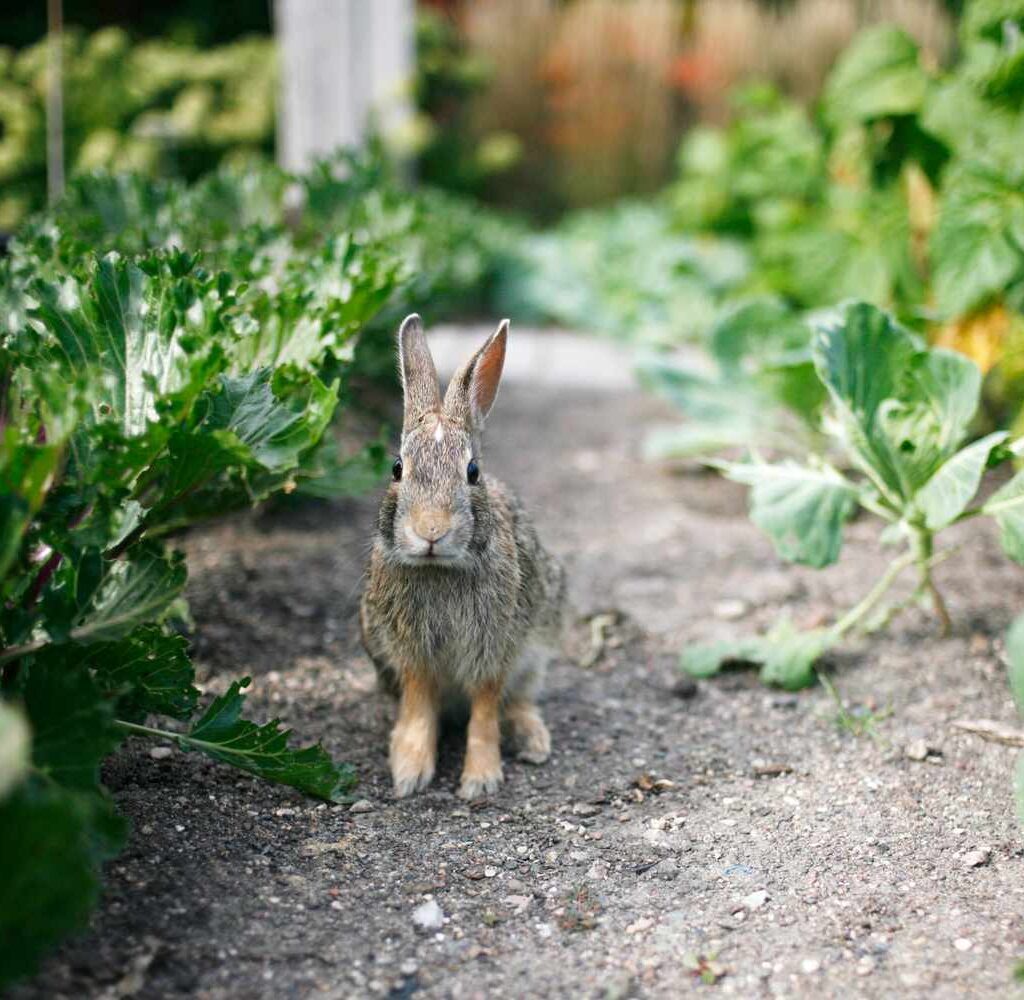If you’re a home gardener, few things are more frustrating than waking up to find your tender greens, blooming flowers, or fresh vegetables gnawed down to stubs. Rabbits may look adorable, but their appetite for garden plants can quickly turn destructive. These cute but crafty critters are notorious for sneaking into yards, feasting on flowers, vegetables, and young shrubs.
The good news? There are plenty of effective, humane ways to guard your greens and keep rabbits at bay without harming them. In this guide, we’ll cover how to spot rabbit damage, why rabbits are so drawn to your garden, and the best natural, physical, and strategic ways to protect your plants.
Let’s hop to it!

Why Do Rabbits Love Your Garden?
Rabbits are herbivores with a preference for soft, succulent, and easily accessible plants. Your garden offers a buffet of exactly what they crave — especially in the early growing season when wild food sources are scarce.
Some of rabbits’ favorite garden treats include:
- Lettuce
- Beans
- Carrots
- Broccoli
- Beets
- Spinach
- Peas
- Pansies
- Petunias
- Tulips
- Young tree saplings and bark
Because rabbits are opportunistic feeders, even plants they don’t usually prefer can fall victim when food is limited.

How to Identify Rabbit Damage
Before you implement defenses, it helps to confirm that rabbits are the ones causing trouble. Signs of rabbit damage include:
- Clean, angled cuts on stems and leaves: Unlike deer who tear, rabbits have sharp incisors that make neat, precise cuts.
- Plants eaten to ground level: Rabbits often munch from the base upward.
- Missing leaves or flowers: Especially on tender annuals and vegetables.
- Small, round droppings: Rabbit pellets are about the size of peas and scattered in feeding areas.
- Rabbit tracks: Look for small, round footprints and longer hind foot impressions.
If you’re seeing these clues, it’s time to take action.

10 Proven Ways to Keep Rabbits Out of Your Garden
1. Install a Rabbit-Proof Fence
The most reliable way to protect your plants is with a sturdy fence. To effectively deter rabbits:
- Use 1/4 to 1/2-inch mesh hardware cloth or chicken wire.
- Bury the bottom of the fence 6–10 inches deep to prevent digging.
- Make sure the fence stands at least 2–3 feet high, as rabbits can jump surprisingly well.
- For extra security, angle the top outward to make climbing difficult.
This is especially useful for protecting vegetable gardens, flower beds, and newly planted trees.

2. Use Natural Rabbit Repellents
Commercial rabbit repellents use strong odors or tastes to discourage nibbling. Look for sprays containing ingredients like garlic, putrescent egg solids, or capsaicin.
When using repellents:
- Apply on dry days and reapply after rain.
- Spray around the garden perimeter and directly on vulnerable plants.
- Alternate between different products to prevent rabbits from becoming accustomed.
DIY repellent option:
Mix 2 tablespoons of cayenne pepper, 2 crushed garlic cloves, and a few drops of dish soap into a gallon of water. Let it steep, strain, and spray it generously on your plants.
3. Plant Rabbit-Resistant Plants
While no plant is completely rabbit-proof, some are less appealing due to their scent, texture, or toxicity. Incorporating these can naturally discourage rabbits from settling in.
Rabbit-resistant plants include:
- Lavender
- Marigolds
- Salvia
- Snapdragons
- Yarrow
- Catmint
- Allium
- Foxglove
- Daffodils
- Peonies
Plant these along garden borders or between rabbit-favorite plants to act as a deterrent.
4. Remove Shelter and Hiding Spots
Rabbits love areas where they can hide and nest. To make your garden less attractive:
- Clear brush piles and dense ground cover.
- Trim tall grasses and low shrubs.
- Keep firewood piles elevated or contained.
- Seal gaps under decks, sheds, and outbuildings.
By removing their hiding places, you reduce the likelihood of rabbits frequenting your yard.
5. Use Raised Garden Beds
Elevating your vegetable and flower beds can physically put your plants out of easy reach. Raised beds at least 18–24 inches high deter rabbits, especially when combined with fencing or cloches (protective plant covers).
This method not only protects against rabbits but also improves soil control and drainage.
6. Install Motion-Activated Devices
Rabbits are naturally skittish and quick to flee from sudden sounds or movements. Motion-activated devices work well in deterring them.
Effective options:
- Motion-activated sprinklers
- Ultrasonic repellers
- Garden lights triggered by movement
These devices startle rabbits without harming them, especially effective in open yard spaces.
7. Apply Physical Plant Barriers
For individual plants, small garden plots, or young saplings, physical barriers are an excellent choice.
Try using:
- Chicken wire cages
- Garden netting
- Plastic tree guards
- Floating row covers for vegetables
Be sure to secure barriers firmly at the base to prevent rabbits from squeezing underneath.
8. Use Scent Deterrents
Rabbits have a keen sense of smell and dislike certain strong odors.
Good scent deterrents include:
- Shredded human or pet hair scattered around plants.
- Blood meal sprinkled in the garden (also a fertilizer).
- Crushed garlic cloves or onions.
- Irish Spring soap shavings placed in mesh bags around your garden.
Refresh scent deterrents regularly for continued effectiveness.
9. Companion Planting
Similar to deer deterrence, companion planting involves mixing plants rabbits dislike alongside their favorites to confuse and repel them.
Ideal companion plants:
- Basil
- Oregano
- Mint (keep it in pots as it can spread aggressively)
- Rosemary
- Onions and chives
These herbs and vegetables not only protect their neighbors but also enhance your garden’s productivity.
10. Be Consistent and Vigilant
Rabbits are persistent creatures. Successful rabbit control depends on consistency:
- Repair fences and barriers promptly.
- Refresh repellents after rain.
- Stay vigilant during peak rabbit seasons (spring and summer).
- Rotate deterrent methods to keep rabbits on their toes (or paws!).
Over time, a combination of these techniques will create an unwelcoming environment for rabbits and preserve your plants.
Final Thoughts
Rabbits may be charming, but their appetite for fresh greens can quickly test any gardener’s patience. Thankfully, with a thoughtful mix of physical barriers, repellents, smart plant choices, and simple landscape adjustments, you can guard your greens without harming these critters.
The key is layering multiple strategies, being consistent, and paying attention to your garden’s vulnerable spots. Whether you opt for a rabbit-proof fence, motion-activated deterrents, or pungent plant companions, you’ll reclaim your garden and keep those hungry hoppers at bay.
Have you had success keeping rabbits out of your garden? Share your tips and tricks in the comments — fellow gardeners will thank you!





Leave A Comment